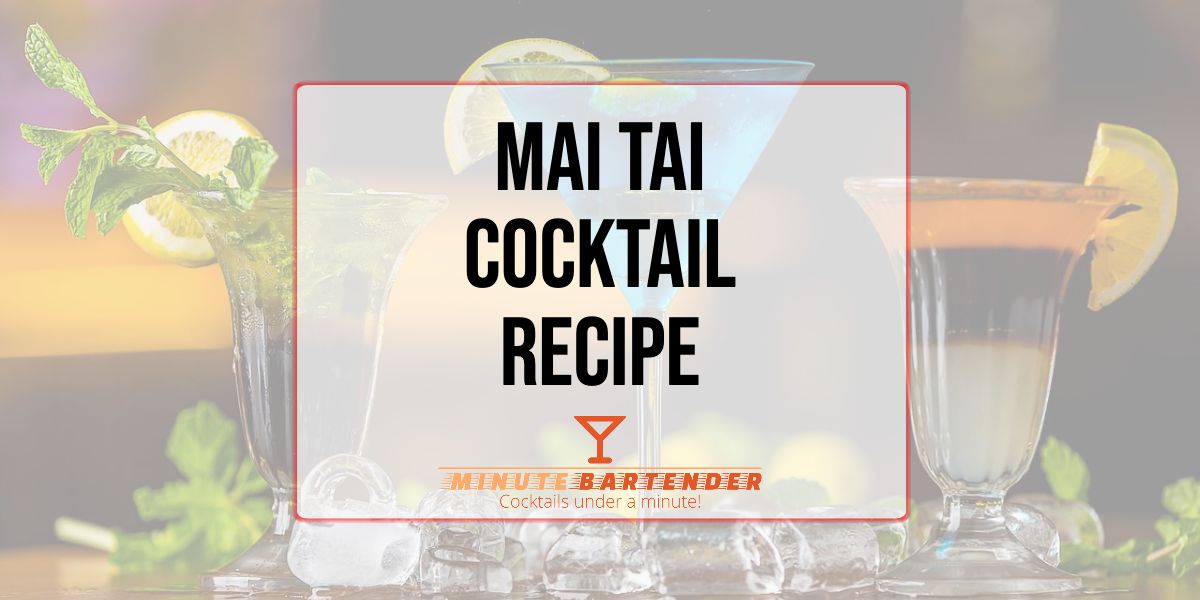The Mai Tai stands as one of the most celebrated tropical cocktails in the world. This rum-based drink brings together sweet, sour, and nutty flavors in perfect harmony. With its rich amber color and fruity aroma, the Mai Tai transports you to a Polynesian paradise with just one sip.
Want to master this classic tiki cocktail at home? This guide covers everything from the original recipe to modern variations, plus serving tips that will impress your guests.
Mai Tai Ingredients
The authentic Mai Tai calls for these key components:
- 2 oz aged Jamaican rum
- 3/4 oz fresh lime juice
- 1/2 oz orange curaçao
- 1/4 oz orgeat syrup (almond syrup)
- 1/4 oz rock candy syrup or simple syrup
- Mint sprig and lime shell for garnish
- Crushed ice
Each ingredient plays a crucial role in creating the balanced flavor profile that makes this cocktail so beloved. The aged rum forms the backbone, while the orgeat adds a subtle almond note that distinguishes the Mai Tai from other tropical drinks.
How to Mix the Perfect Mai Tai
Follow these steps to create this classic cocktail:
- Fill a cocktail shaker with ice
- Add rum, fresh lime juice, orange curaçao, orgeat syrup, and simple syrup
- Shake vigorously for about 10 seconds
- Fill a rocks glass or traditional Mai Tai glass with crushed ice
- Strain the mixture into the glass
- Save one spent lime shell and place it in the drink
- Garnish with a fresh mint sprig next to the lime shell
- Serve immediately
The key to a great Mai Tai lies in the balance between sweet and sour elements. Too much sweetness overpowers the rum, while too much lime makes it unpleasantly tart. Measure your ingredients carefully for the best results.
Ingredient Swaps and Alternatives
Can’t find all the traditional ingredients? Try these substitutions:
For the rum:
- Blend of dark and light rums instead of aged Jamaican rum
- Aged Martinique rum for a different flavor profile
- Non-alcoholic rum extract mixed with water (for a mocktail version)
For orgeat syrup:
- Amaretto liqueur (use slightly less)
- Homemade almond syrup (almond extract + simple syrup)
- Falernum syrup (adds clove and lime notes)
For orange curaçao:
- Triple sec
- Grand Marnier
- Orange juice reduction with a dash of orange extract
The versatility of the Mai Tai allows for customization while maintaining its essential character. Experiment with these alternatives to find your perfect version.
What Makes the Mai Tai Stand Out
The Mai Tai excels because of its perfect balance. Unlike many tropical drinks that rely on excessive sweetness, the Mai Tai showcases the rum while supporting it with complementary flavors.
The combination of almond, citrus, and aged rum creates complexity rarely found in other cocktails. Each sip reveals different notes—first citrus, then rum, finishing with almond and caramel undertones.
The drink also carries a sense of occasion. When you order or make a Mai Tai, you’re not just having a drink—you’re participating in a tradition that spans decades of cocktail culture.
The Rich History of the Mai Tai
The Mai Tai comes with a disputed origin story that adds to its mystique. Victor “Trader Vic” Bergeron claims to have created it in 1944 at his Oakland restaurant. After serving it to Tahitian friends, they reportedly exclaimed “Maita’i roa ae!” meaning “Out of this world! The best!” in Tahitian—giving the cocktail its name.
Donn Beach of Don the Beachcomber restaurants disputed this claim, saying he created a similar drink in 1933. The debate continues among cocktail historians.
Regardless of its exact origins, the Mai Tai gained massive popularity in the 1950s and 1960s during America’s tiki culture boom. The cocktail became a symbol of tropical escapism and Polynesian-themed entertainment.
The original recipe evolved over time as rum supplies changed after WWII. Trader Vic’s later versions used a blend of different rums to recreate the flavor of the original’s 17-year-old J. Wray & Nephew rum that became unavailable.
Flavor Profile Breakdown
The Mai Tai presents a complex flavor journey:
- First impression: Bright citrus with rum warmth
- Mid-palate: Nutty almond notes from the orgeat
- Finish: Lingering caramel and oak from aged rum
The drink balances sweet, sour, strong, and nutty elements. The lime provides acidity that cuts through the sweetness of the syrups, while the orange curaçao adds depth and complexity.
Unlike many modern tropical drinks, an authentic Mai Tai contains no pineapple or orange juice. This allows the quality of the rum to shine instead of being masked by fruit juices.
Serving Your Mai Tai Right
To present your Mai Tai like a professional bartender:
- Use a double old-fashioned glass or traditional Mai Tai glass
- Pack with crushed ice, not cubes
- Garnish with a fresh mint sprig and spent lime shell
- Consider adding a paper parasol for classic tiki presentation
- Serve with a short straw
The visual appeal matters almost as much as taste. The lime shell and mint garnish create an aromatic experience before the first sip, enhancing the overall enjoyment.
For large gatherings, you can pre-mix the rum, lime juice, and syrups. Store this base in the refrigerator, then shake with ice and pour over crushed ice when ready to serve.
Perfect Food Pairings
These appetizers complement the Mai Tai’s flavor profile:
- Coconut shrimp with sweet chili sauce
- Pork or chicken satay with peanut sauce
- Ahi tuna poke with sesame
- Grilled pineapple skewers
- Macadamia nut crusted cheese balls
The tropical flavors in the Mai Tai work well with:
- Sweet and savory combinations
- Foods with nutty elements (echoing the orgeat)
- Polynesian and Asian-inspired dishes
- Grilled seafood with fruit salsas
The cocktail’s acidity helps cut through richer foods, making it a versatile pairing option for various appetizers and main courses.
Mai Tai ABV (Alcohol By Volume)
The Mai Tai ranks as a relatively strong cocktail. With 2 ounces of rum as its base (typically 40% ABV), plus orange curaçao (also containing alcohol), a standard Mai Tai contains about:
- 27-30% ABV in the mixed drink
- Approximately 1.7-2 standard drinks per serving
This places it higher in alcohol content than many popular cocktails like Mojitos or Daiquiris. The strong rum backbone gives the Mai Tai its characteristic potency, making it a cocktail to enjoy slowly and responsibly.
Nutritional Information
For those tracking their intake, here’s what to expect from a standard Mai Tai:
- Calories: Approximately 230-260 calories
- Carbohydrates: 20-25g (primarily from the syrups)
- Sugar: 18-22g
- Fat: <1g (trace amounts from orgeat)
- Protein: 0g
The calorie content comes mainly from the alcohol and sweeteners. For a lighter version, you can reduce the simple syrup or use a sugar-free alternative, though this will alter the authentic flavor profile.
Final Tips for Mai Tai Success
Making a great Mai Tai at home depends on these factors:
- Quality rum makes a dramatic difference—invest in a good bottle
- Fresh lime juice is non-negotiable—never use bottled
- Proper dilution through shaking and crushed ice balances the flavors
- Homemade orgeat syrup tastes noticeably better than commercial versions
Have you tried making other tiki cocktails? The Mai Tai serves as an excellent gateway into exploring more complex tropical drinks like the Zombie, Navy Grog, or Fog Cutter.
Start with mastering the classic recipe before experimenting with variations. Once you understand the balance of flavors, you can create your own signature version that stays true to the spirit of this legendary cocktail.
Whether you’re hosting a luau, a summer barbecue, or just want to bring some tropical flair to your home bar, the Mai Tai delivers a taste experience that has stood the test of time for good reason.











